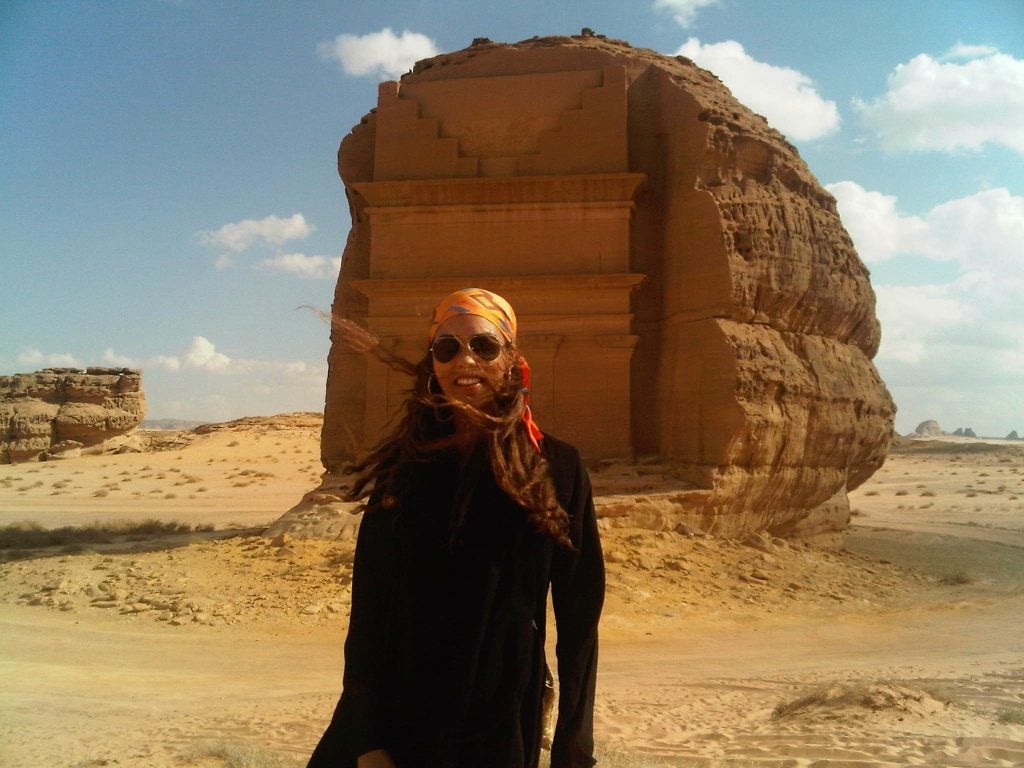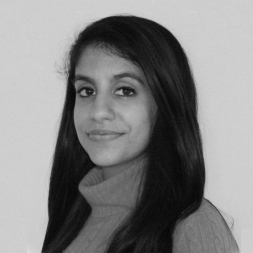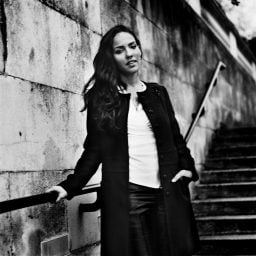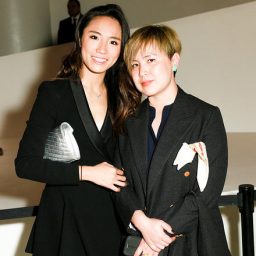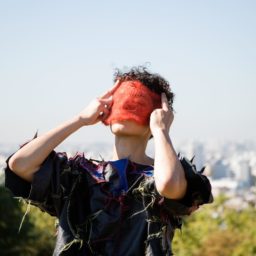A descendant of Libyan royalty, Princess Alia Al-Senussi grew up between Egypt, South Dakota, and Minnesota, moving between seemingly disparate cultures and finding her sense of self through the art in the American and Libyan homes she lived in, the museums she visited, and in the heritage sites she fell in love with.
Al-Senussi—a London-based scholar, curator, collector, and patron of the arts who works with institutions and art fairs worldwide—has, over the course of her career, sought to bring the world closer together through her work, in which she seeks to illustrate how art can be a catalyst for social change.
Below, Al-Senussi spoke to Artnet News about the art that filled her childhood, what she collects now, why she feels art can be a vehicle for diplomacy, and much more.
How old were you when you first started engaging with art? Is there a particular work of art you remember seeing as a child that really wowed you?
I would say that art was more infused with travel for me, so it was more about the idea of experiencing a culture. It wasn’t so much about connecting with art through a painting or particular work, but rather the moment I experienced the feel and texture of a culture through a monument or through heritage, because my life was a combination of, in the most literal sense, Arab and American identities. It wasn’t ever that I was an Arab-American—it was that my mother was American and my father was Arab, and I would be traveling between those two lives and households and cultures.
Even though I grew up in Cairo, and some of my happiest memories are of visiting the pyramids, I was also experiencing them as a tourist because my grandparents from Minnesota would be coming to visit and we’d see them altogether. Examining these incredible places with which I was really familiar, but also seeing them through outsider’s eyes is in part how I learned about art, in a wider sense than just what I saw by stepping into a museum. That informed my life absolutely, and I would say that the reason that I jumped into the world of contemporary art is because I saw how important contemporary art could be and is in explaining who we are in the present moment.
In terms of a specific, contemporary work, going to see Olafur Eliasson’s The Weather Project (2003) at Tate Modern left an impression on me. As much as it’s a cliche, I think so many of us would say that. You know, [former Tate director] Nick Serota said that work was a defining moment for him and for the museum world and for the world of contemporary art in terms of how people think about public spaces—and how museums are now seen as public spaces rather than just these temples to art and culture. I found that to be true.
And then, of course, when we traveled, my mother would always take me to museums. When I did my college touring, we went to MoMA and the Met in New York. Museums were always a part of going on a trip. Later on, I came to London with a group of girlfriends for a long weekend, mainly to experience the Tate Modern, which at that time was really groundbreaking, and of course still is, but then it was brand new—it was January 2001 or 2002. I remember visiting with these girlfriends who were like, “We have to go see this place! We have to go see this new museum, oh my gosh!” It was such an incredible thing. And through these experiences, I started to understand the ways in which art interplays and is interwoven between the larger themes of the world in which we live, and the world in which we aspire to live in.
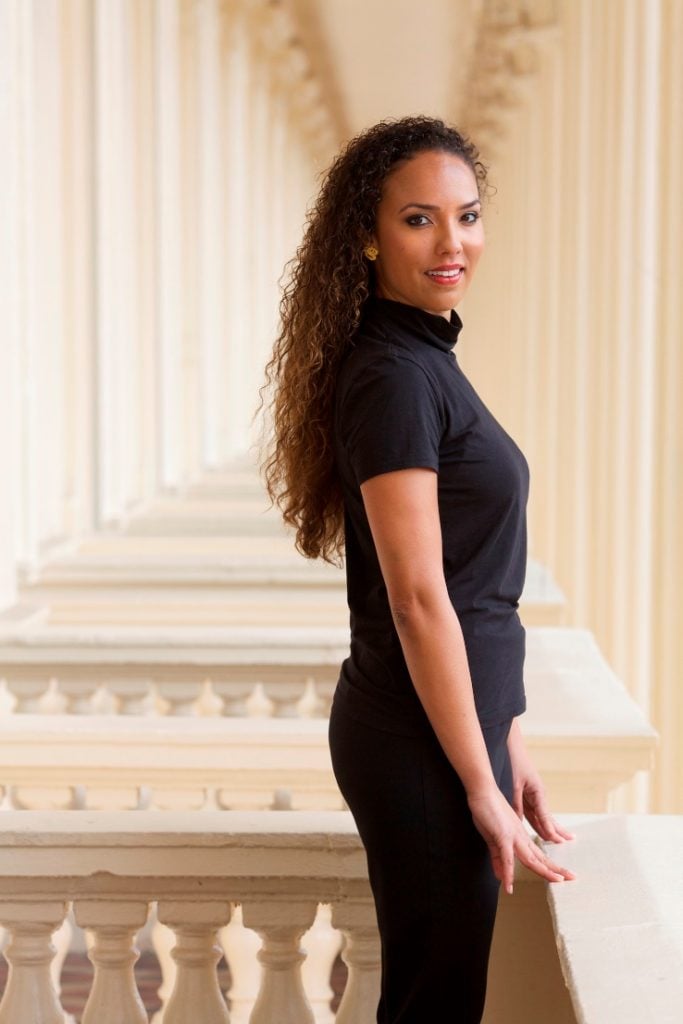
Alia Al-Senussi at the ICA London prior to the opening of the group exhibition “Hong Kongese” at Duddell’s Hong Kong (2015). Photo courtesy Alia Al-Senussi.
You recently completed your PhD dissertation, which explores the connections between art and social change in Saudia Arabia and beyond. Your work suggests that art can assist in diplomacy, and in its own way help to solve humanitarian issues around the world. How did you become interested in this nexus?
Throughout my time at university, I was always really interested in alternative forms of diplomacy. So my focus was international relations and Middle East studies, and I intended to pursue pre-med as well, but then I shifted my focus.
September 11th happened when I was in university. I was a sophomore. I started really thinking about how perceptions of people are so incredibly important to how we treat them and how whole cultures are treated. I did my senior dissertation on Saudi public relations campaigns after September 11th. What it really addressed was how you talk about people after something like that. You know, you can’t paint the entire people of a country based on one heinous act. And as somebody who’s also American, I also hope the same applies to me and how people perceive me. As somebody from a family who has had a kind of brutal and really sad history in Libya, I’d always want people to think more of me—someone who is half-Libyan—than [former Libyan leader Muammar Gaddafi], who acted horribly and despicably to so many.
I was really drawn to this idea in general and it was always something I was very focused on throughout my internships and throughout my classes. I moved to London and was introduced to the mother of a friend I went to school with, who was overseeing this art project in Siwa, Egypt, lead by Ilya and Emilia Kabakov. She introduced me to Michael Hue-Williams, the gallerist at Albion Gallery that was hosting the project. It was a nonprofit arm of the gallery at the time that brought artists to create works in Siwa. And he was like, “Okay, come!”
It was a three-month project and Michael and I got along and he appreciated my background in Middle Eastern history. Siwa also has a lot of Senussi, or people who are a part of our family’s [socio-political] sect. There were so many interlacing narratives, it just seemed really fit.
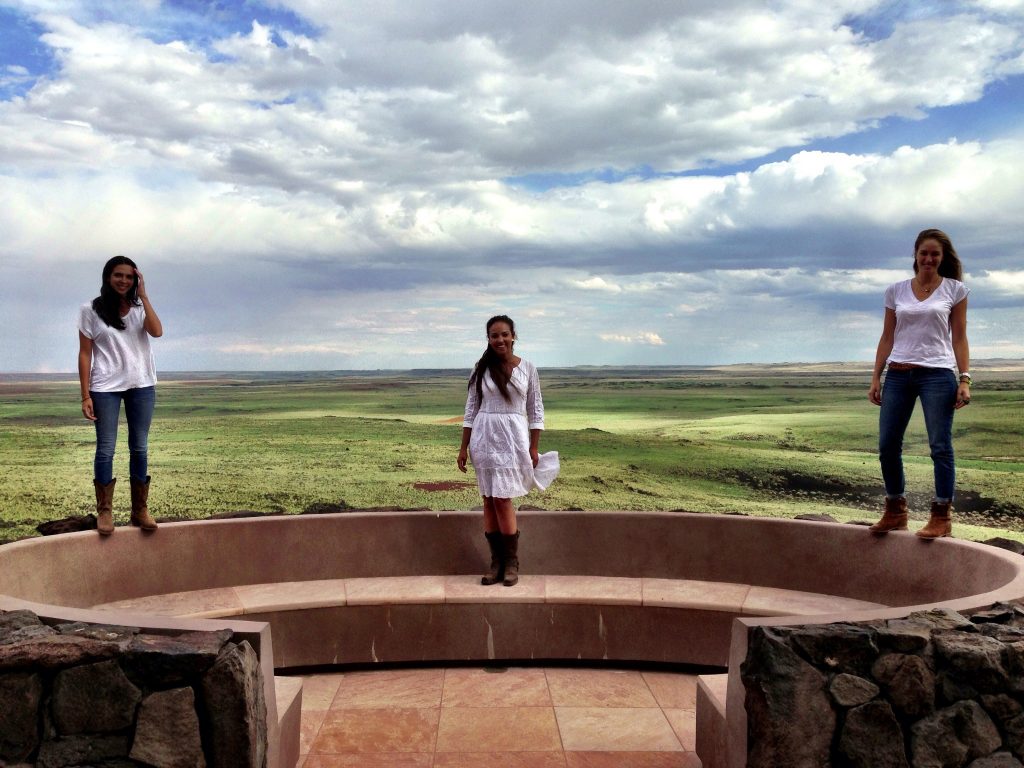
Al-Senussi with friends at Roden Crater. Photo courtesy Alia Al-Senussi.
I handed in my dissertation about a week later and then the Frieze art fair started—I had no idea what that was at the time. I was 22 years old and everyone as getting ready for Frieze, and I had to go get the project ready in Siwa, which people planned to visit after Frieze. So I flew to Egypt and landed in Cairo, where I hadn’t been in any meaningful way since I was a very little girl. It was incredible—I got off the plane, got in a car with the studio manager, the Kabakovs, and off we went on a 10-hour car journey to the middle of the desert on the border of Libya, a country I had never been to. And there I was. The townspeople knew that I was a Senussi, which still holds a great deal of meaning there. It was very emotional and really touching in so many ways. It sounds like a story from a movie in a sense, and it really was. I arrived there and I worked with all these incredible artists and just fell in love with art.
I saw with my own eyes the power of art to change not only my life, but the lives of others: the people who had taken me there and the artists themselves—who are Russians who were exiled to America—and most importantly, the people of Siwa. It was kind of a summation of all of my academic studies until then. I fell in love with the art world and everything it meant.
And yes, of course, I know that there’s so much other stuff that’s problematic in terms of the market and so many other aspects. But really, to me, that is the heart and soul of the work I’m trying to do, and I think the work of people with good intentions, who work thoughtfully in this industry.
You’re involved with several arts patronage groups, like the Tate Young Patrons, for which you serve as chairman of the board. Tell me about all that you do in the patronage and community space.
That really came about once I came back from Siwa after having this incredibly enlightening experience. Everything just clicked after that. I joined Albion Gallery as a manager for artists’ projects and began liaising with so many artists, meeting and working with them, discovering their stories. I was also invited to join groups like Tate Young Patrons, which was at the time just starting. The Siwa project was October of 2005, and all of those groups were formed within a year or two later.
It was a moment of great promise in London, where the London art world was awakening to a different kind of community patronage effort. The regional acquisitions committees at Tate were being formed, for example. My work related to the Middle East was so intertwined with all that was happening in that moment, too, as perhaps the first Arab woman at a commercial gallery focused on that world. Saadiyat Island [in Abu Dhabi] was announced within a year or two after. In those years, I really delved into these projects because I truly believed that community is a part of whatever it is that we’re trying to form in the art world, and I think that these patronage groups and committees and these social functions and dinners are really important for bringing people together in an alternative setting to something more transactional or straightforward or academic. It’s another way of reaching people, which I feel is so necessary. Tate Young Patrons holds a really special place in my heart.
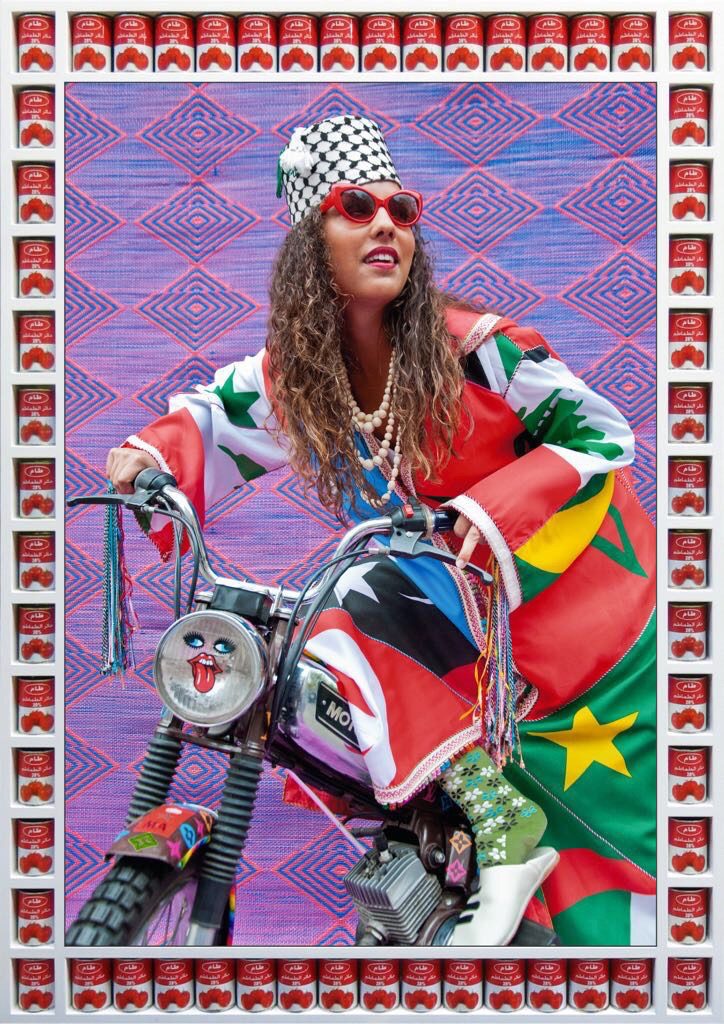
Alia Al-Senussi by Hassan Hajjaj. Photo courtesy Alia Al-Senussi.
You’re also an art collector. When did you start collecting art? And what are the kinds of things that you like to live with?
I’m not an avid art collector in the way that others might be described as avid collectors, but things that are meaningful to me are things that I want to live with. Actually my best friend, Abdullah Alturki—who actually is a prolific art collector and one of the best of our generation—once said to me, “Don’t say you’re not an art collector! You’re a collector of art experiences.”
And that’s really true, I am the person who collects and curates experiences for everyone, and I take them to Marfa and Roden Crater or Naoshima in Japan, where I went with 20 friends who were not necessarily all art people. Along the way, I’ve created a collection of objects at home for myself. Eddie Peake became a very good friend early on and I supported his work at Performa and have a work of his at home. I did Oscar Murillo’s first public talk with Gregor Muir and we’ve remained friends.
More recently, I’ve really started to rethink this idea of acquiring because I went through a period of doing my PhD and frankly really struggling in a variety of ways. I had deep emotional struggles with all of that and and with thinking about what’s next.
Thankfully, I remerged and I’m really grateful that I’m able to be a source of strength within myself but then also for my friends and family and the community in this period of the pandemic. One of my first real acquisitions was Hank Willis Thomas’s Kama Mama, Kama Binti work from his show at Jack Shainman that talked about so much. It just struck me because my mother is the most important person in my life and has been so supportive of me, though she doesn’t involve herself in my professional life in many ways. She’s not very social, she doesn’t really involve herself in the art world, although she’s very supportive of the arts and always took me to museums as a child. And so to see that work featuring a mother and a daughter looking at each other with so much love in Art Basel’s online viewing rooms was really special.
Art Basel, too, has been a great source of strength and really supports me. I think it’s an incredible organization and I’m so proud of the ways in which we support galleries and artists as a cornerstone of the art world. I’m a true believer in the gallery system. Now I see myself in this phase of my life, collecting experiences but also beginning to collect works that are emotionally meaningful to me.
In an earlier interview, you mention your mother’s ivory as the most precious thing that you own. Tell me about that and the other objects of meaning that you grew up with that maybe aren’t classified as “art” per se, but informed your eye nonetheless.
I do think the cultural objects that defined my experience between Egypt and Minnesota were kind of given shape by objects. Things became markers, in a sense, of each place: I would go with my grandmother every day to the mall in Montessori to have pizza and ice cream and I remember going home with her to this exquisitely decorated house. At the time, middle-class American society really appreciated international aesthetics and my grandmother loved this kind of Asian Art Deco sensibility. We still have those objects in her home, she’s still living in that house.
In my Arabic household, it was about the things that my mother has passed down now—her ivory, which was a gift from my father, and my grandfather’s caftans, these incredible traditional Libyan men’s silk caftans, which I inherited and wear now, in part because we can wear it now. I still keep those things and they certainly contributed to this idea of childhood art and works of craft that influenced me.

Um Kulthum next to Al-Senussi’s grandfather, HRH Prince Abdallah Abed Al-Senussi. Photo courtesy Alia Al-Senussi.
Who are a few artists you have your eye on right now who you feel more people should know about?
Dana Awartani, a talented and sensitive young artist who’s continuously evolving ancient Islamic practices for the world today, and Manal AlDowayan, a feminist who has changed the course of Saudi history and our own perceptions of a woman’s role and place in many ways. Manal uniquely understands and is proud to be a Saudi woman and celebrate her family’s history and her own artistic development. Of course there’s Hank Willis Thomas, whose work I adore, and Taryn Simon, who’s also a friend. Basim Magdy, an Egyptian artist living in Basel, he’s a great friend there’s a wonderful sense of overlap in the places that we both love.
And then beyond specific artists, it’s also really important to me to name parts of the world that we have not focused on or always see as “the Other.” And I think, for me, and especially my work in Saudi Arabia, that can be frustrating—you know, this is a country of 40 million people that has deep culture and an ancient history, and so when I read certain articles by people who are actually friends talking about, you know, “this modern pop-up town,” I’m thinking, “Okay… a modern pop-up town that is… how many millennia old?” Like… excuse me? Sorry, no. [laughs] Just because you did not hear about it before does not mean it is not ancient. I think it’s really important to look at parts of the world that have been closed off. I think if we were to look at China 20 years ago and compare it to what’s happening Saudi Arabia now… you know, one of my dearest friends who I respect so much, Philip Tinari at UCCA, was talking about the history of China and Chinese art, was making connections between those two time periods and cultures. It’s important that we try to look further.
I’ve also learned a lot through my work with 1:54, the Contemporary African art fair. I’m a founding member of their board and we look at what’s happening all over Africa. I went to the Dakar Biennale two years ago, and I was in Accra just before the lockdown in March. While I was there, I was able to visit these incredible spaces and of course people are looking more and more at African art, but always in the context of African art rather than, “Oh, it’s art from Africa, but part of our art world.” I think those are two very different ways of looking at it, and we should bend towards the latter. There’s just so much undiscovered or underrepresented art and artists.
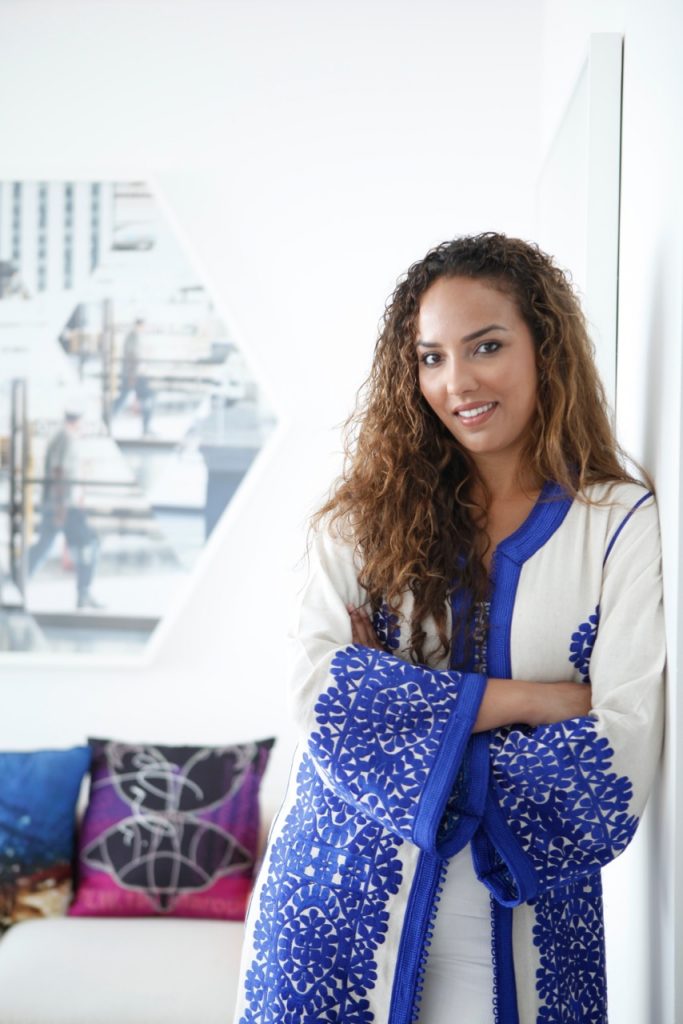
Al-Senussi in a Moroccan caftan, purchased during a trip to Marrakech. Photo courtesy Alia Al-Senussi.
What do you hope for the future of the art world? Where do you want it to be in five years’ time?
I hope that we don’t reject the idea of community. And I really hope that the art world becomes the inclusive place that it’s always aspired to be and has always attested to be. I think that this moment is a moment of reflection. I also think this moment is a moment of reckoning and unfortunately we will see certain cases that are unfair, cases of people barely getting by and certain institutions going through periods of hardship. But frankly those conversations should be happening and are necessary. I really hope, at the end of the day, that there’s a sense of strength and support for one another and that we’re able to tap into that.
